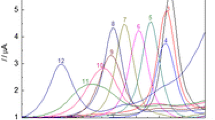Abstract
The reduction of SO2 with different concentrations at a platinum microelectrode was investigated by cyclic voltammetry (CV) in 1-(butyl)-3-methylimidazolium hexafluorophosphate ([Bmim]PF6). We speculated that the reaction mechanism of reduction may form a macromolecular complex, and the higher the concentration of SO2, the larger the molecular weight of the complex. The higher the concentration of SO2, the greater the diffusion coefficient of SO2 in [Bmim]PF6. There is a good quadratic function relationship between the reduction peak current and SO2 concentrations in the range from 2% to 100%, which promises a kind of ionic liquid electrolyte for the detection of SO2 gas with a wide range of concentrations.
Similar content being viewed by others
References
Wasserscheid P, Welton T. Ionic Liquids in Synthesis [M]. Weinheim: Wiley-VCH, 2002.
Armand M, Endres F, Macfarlane D R, et al. Ionic-liquid materials for the electrochemical challenges of the future [J]. Nature Materials, 2009, 8(8): 621–629.
Buzzeo M C, Hardacre C, Compton R G. Use of room temperature ionic liquids in gas sensor design [J]. Analytical Chemistry, 2004, 76(15): 4583–4588.
Huang Q, Li W, Wu T, et al. Monoethanolamine-enabled electrochemical detection of H2S in a hydroxyl-functionalized ionic liquid [J]. Electrochemistry Communications, 2018, 88: 93–96.
Huang Q, Li Y, Jin X B, et al. Chloride ion enhanced thermal stability of carbon dioxide captured by monoethanolamine in hydroxyl imidazolium based ionic liquids [J]. Energy & Environmental Science, 2011, 4(6): 2125–2133.
Sun H J, Yu L P, Jin X B, et al. Unusual anodic behaviour of chloride ion in 1-butyl-3methylimidazolium hexafluorophosphate [J]. Electrochemistry Communications, 2005, 7(7): 685–691.
Wang R, Hoyano S, Ohsaka T. O2 gas sensor using supported hydrophobic room-temperature ionic liquid membrane-coated electrode [J]. Chemistry Letters, 2004, 33(1): 6–7.
Dyson P J, Laurenczy G, Ohlin C A, et al. Determination of hydrogen concentration in ionic liquid and the effect (or lack of) on rates of hydrogenation [J]. Chemical Communications, 2003, 19: 2418–2419.
Broder T L, Silvester D S, Aldous L, et al. Electrochemical oxidation of nitrite and the oxidation and reduction of NO2 in the room temperature ionic liquid [C2mim][NTf2] [J]. The Journal of Physical Chemistry B, 2007, 111(27): 7778–7785.
Buzzeo M C, Giovanelli D, Lawrence N S, et al. Elucidation of the electrochemical oxidation pathway of ammonia in dimethylformamide and the room temperature ionic liquid, 1-ethyl-3-methylimidazolium bis(trifluoromethylsulfonyl)imide [J]. Electroanalysis, 2004, 16(11): 888–896.
Barrosse A L E, Silvester D S, Aldous L, et al. Electroreduction of sulfur dioxide in some room-temperature ionic liquids [J]. The Journal of Physical Chemistry C, 2008, 112(9): 3398–3404.
Potteau E, Levillain E, Lelieur J P. Mechanism of the electrochemical reduction of sulfur dioxide in non-aqueous solvents [J]. Journal of Electroanalytical Chemistry, 1999, 476 (1): 15–25.
Bruno P, Caselli M, Traini A. Study of sulfur dioxide reduction mechanism in dimethyl sulfoxide [J]. Journal of Electroanalytical Chemistry, 1980, 113(1): 99–111.
Martin R P, Sawyer D T. Electrochemical reduction of sulfur dioxide in dimethylformamide [J]. Inorganic Chemistry, 1972, 11(11): 2644–2647.
Winlove C P, Parker K H, Oxenham R K C. The measurement of oxygen diffusivity and concentration by chronoamperometry using microelectrodes [J]. Journal of Electroanalytical Chemistry, 1984, 170(1–2): 293–304.
Bard A J, Faulkner L R. Electrochemical Methods: Fundamentals and Applications [M]. 2nd Ed. New York: John Wily & Sons, 2001.
Author information
Authors and Affiliations
Corresponding author
Additional information
Foundation item: Supported by the Natural Science Foundation of Hubei Province (2018CFC827) and College Outstanding Young Scientific and Technological Innovation Team of Hubei Province (T201620)
Biography: HUANG Qing, female, Lecturer, Ph. D., research direction: electrochemistry in ionic liquids.
Rights and permissions
About this article
Cite this article
Huang, Q., Hu, Y., Wang, J. et al. The Principle of Detect SO2 Concentration by Using the Electrochemical Method in Ionic Liquid. Wuhan Univ. J. Nat. Sci. 24, 400–404 (2019). https://doi.org/10.1007/s11859-019-1412-8
Received:
Published:
Issue Date:
DOI: https://doi.org/10.1007/s11859-019-1412-8




